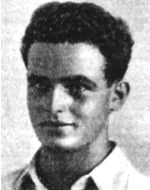Huberman, Issachar (“the fighter Yankele”)
Son of Sarah and Abraham, was born on 7.10.1927 in Warsaw, the capital of Poland, and in 1932 immigrated with his parents to Israel and the family settled in Tel Aviv. After graduating from elementary school, he worked in clerkship. He was an active member of the Scout and Maccabi movement, was particularly interested in sports as an active player and as a guide and aspired to study abroad in sports and body culture. In 1943 he left for a year of service at Ramat Hakovesh, where he received his first military training. In 1944, he was hired as a driver in the British Army and learned how to contact the British and to arrange service and guarding in their camps and trips, and his knowledge was useful to him when he joined the Lehi underground. In Lehi operations against the British and Arabs in Jerusalem. In March of that year he briefly went down to Tel Aviv and, accompanied by the last convoy, before he cut off the road, returned to fight for Jerusalem. Issachar participated in the activities of the Lehi units in the occupation of Sheikh Bader, Romema, Deir Yassin, etc. He was famous for his boldness and courage, and even when he was wounded and could recover at home, he did not wait until he recovered and returned to battle. The wall of the Old City On the following day, on the 15th of Iyar 5708 (May 15, 1948), he continued on his journey to the “Notre Dame” building, and with his girlfriend he went up to the roof of the building to review the situation and the possibility of continuing the action to the Old City. He was buried in Sanhedria in Jerusalem. His girlfriend-in-arms, who was also his fiancée, fell in battle not long after he fell. On the 9th of Cheshvan 5711 (8.11.1951) he was transferred to the eternal military cemetery at Mount Herzl in Jerusalem.
